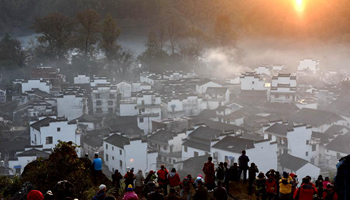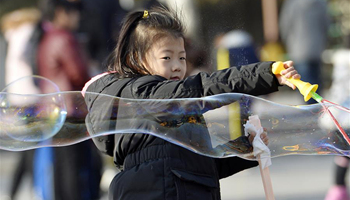ZHENGZHOU, Nov. 28 (Xinhua) -- As the nights grow longer and the temperatures drop, visitors flock to a wetland park in central China's Henan Province to see thousands of white swans.
The swans from Siberia, make their way to the 28,500-hectare Sanmenxia Yellow River wetland park on their annual migration.
Great changes have taken place, said resident Zhang Mingyun. "Fifteen years ago there were no birds to be seen on this wetland," said Zhang.
This year, park rangers have counted 8,000 swans but they are confident that the population will exceed 10,000 by late December, according to Li Yunfeng, manager of the wetland.
"The number of birds here reflects the state of the habitat," said Wang Ruiling, an ecologist with Yellow River Basin Water Resources Protection Bureau. "White swans do not choose low quality waters."
Sanmenxia parks department has seen an increase in the number of swans during the annual migration season from November to March. Over 60 percent of all swans who winter in China choose the city, earning it the reputation as "the city of swans."
Sanmenxia wetland is fed by the Yellow River, which was once dirty and polluted, decades ago, only a handful of swans braved the waters.
In 2011, Sanmenxia began work on the Yellow River Wetland Park, part of the wider Yellow River National Nature Reserve.
Residents were too scared to use the river water 15 years ago, said Zhang. "The tap water, which was processed from the Yellow River, had an odd smell."
Unlike the birds, who could just fly away from polluted habitats, residents had families, businesses and a life they could not just leave behind.
The Yellow River is the second longest river in China, supplying water for 164 million people and over 60 large- and medium-sized cities.
"The river has one of the most complicated runoff-and-sediment load relationships, which makes it very hard to manage and protect," said Minister of Water Resources Chen Lei.
From 1980 to 2000, water quality in the Yellow River Basin deteriorated sharply, according to a report released by the Yellow River Conservation Commission (YRCC).
The commission responded with strict water management rules and annual water quotas for provinces along the Yellow River.
"Since the mechanism was implemented in 1999, water overuse has dropped significantly, helping the river to recover by itself," said Pei Yong, director of YRCC department of water resource management and regulation.
In 2000, water in only 38.1 percent of the river could be processed for drinking or daily use. By 2015, the percentage had increased to 63.5 percent, said a report by the commission.
Sanmenxia had many polluting factories, so the local government introduced higher environmental standards for new projects and suspended operation of highly-polluting, energy-guzzling companies.
The municipality has shut down over 20 power plants and over 800 metal production floors in recent years.
In the long term, a greener environment in the Yellow River Basin is key, said Zhang Jinliang, an expert with YRCC.
"Year by year, more and more birds migrate here and people are seeing more improvements along the Yellow River," said Li. "Protection of the birds, Yellow River and environment has become a common consensus."










